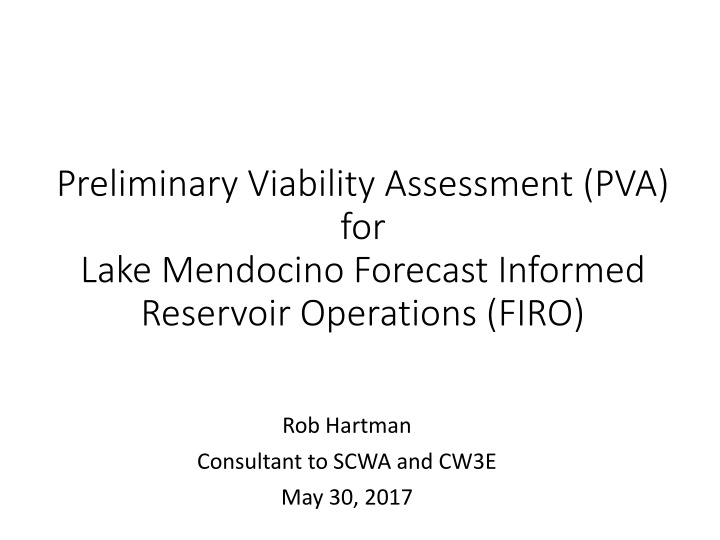
Lake Mendocino FIRO Viability Assessment: Key Questions & Approach
Explore the Preliminary Viability Assessment (PVA) for Lake Mendocino's Forecast Informed Reservoir Operations (FIRO) conducted by Rob Hartman, addressing the importance of the assessment, key questions, approach, and components involved. The assessment aims to determine if implementing FIRO would enhance water management objectives while considering environmental flow requirements and flood risk management, emphasizing the need for improved meteorological and hydrological forecast skills. The approach focuses on establishing the merit of the strategy for further pursuit, with studies examining the use of forecasts for water supply reliability and flood mitigation. Additionally, details are provided on the experimental design by SCWA, including the Daily time step MATLAB model and various operational modes considered. Lastly, insights into the SCWA EFO process and results are highlighted, outlining the steps taken to mitigate risks and optimize reservoir storage in Lake Mendocino.
Download Presentation

Please find below an Image/Link to download the presentation.
The content on the website is provided AS IS for your information and personal use only. It may not be sold, licensed, or shared on other websites without obtaining consent from the author. If you encounter any issues during the download, it is possible that the publisher has removed the file from their server.
You are allowed to download the files provided on this website for personal or commercial use, subject to the condition that they are used lawfully. All files are the property of their respective owners.
The content on the website is provided AS IS for your information and personal use only. It may not be sold, licensed, or shared on other websites without obtaining consent from the author.
E N D
Presentation Transcript
Preliminary Viability Assessment (PVA) for Lake Mendocino Forecast Informed Reservoir Operations (FIRO) Rob Hartman Consultant to SCWA and CW3E May 30, 2017
Key Questions for the PVA 1. If FIRO is implemented, will operation improve reliability in meeting water management objectives and ability to meet environmental flow requirements, and to what extent? 2. If FIRO is implemented, will operation adversely affect flood risk management in the system? If so, where and to what extent can that be mitigated? 3. What meteorological and hydrological forecast skill is required to enable FIRO to be implemented? Is current forecast skill for landfalling ARs (and their associated heavy precipitation and runoff) and other extreme precipitation events adequate to support FIRO, and what improvements would be needed to enable full implementation of FIRO for Lake Mendocino?
PVA Approach The PRELIMINARY Viability Assessment was not designed to be comprehensive and conclusive. The goal was/is to establish (to the satisfaction of the steering committee and the funding agencies) whether or not the strategy has merit for Lake Mendocino worthy of further pursuit.
PVA Components A study by SCWA to assess if explicit use of forecasts can yield improved water supply reliability without impacting flood mitigation A study by USACE HEC to assess if using forecasts leads to compromised flood risk objectives A series of studies by CW3E to assess existing forecasts and their suitability for use in FIRO assessments
SCWA Experimental Design Daily time step MATLAB model Considers release restrictions, rate of change limits, downstream controls and objectives Run in 4 modes Existing (rule curve) operations Perfect forecast assumption Ensemble Forecast Operations (EFO) Hybrid EFO with elevated mid-winter conservation storage EFO and Hybrid EFO Mitigate risk of reaching 111 KAF storage in Lake Menocino Leverages 1985-2010 HEFS reforecast of inflow and ds locals (15-day)
HEC Experimental Design Assess Flood hazard (frequency and magnitude of flows) Performance of CVD to reduce flood hazard Consequence (damages) of excessive flows System Modeling HEC HMS (watershed response) HEC ResSim (reservoir operations) HEC RAS (routing) HEC FIA (risk analysis and impacts) Rainfall sequences Statistically derived Historical (1950-2010)
HEC Experimental Design Metrics Average Annual Damage (AAD) Expected Annual Damage (EAD) WSEL and flow at CVD and downstream locations (stage frequency curves) Available CVD storage for conservation Alternatives Considered Existing operations Encroach Perfect Forecasts EncroachWIF Imperfect Forecasts Combined hybrid operations
CW3E Inquiries 1. What is the required forecast lead time? 2. What are the forecast requirements for extreme rainfall events? 3. What is the current forecast skill level for rainfall that has an impact on Lake Mendocino operation? 4. What is the current skill in forecasting no significant rainfall (AR landfall)? 5. Will current streamflow forecasts support FIRO for Lake Mendocino?
CW3E Inquiries 6. Are the ensemble precipitation forecasts suitable for testing and evaluating FIRO strategies as SCWA did? 7. How important are extreme rainfall events to annual precipitation in the Russian River watershed? 8. What is the relationship of upslope water vapor flux and rainfall for land-falling ARs? 9. What is the impact of frontal waves along ARs on flood forecasting in the Russian River Basin?
CW3E Results Detailed analysis provided in PVA Appendix 3. Bottom line Existing forecasts (precipitation and streamflow are skillful and suitable for assessing FIRO alternatives Forecast skill for low-frequency, high intensity AR events is lower and requires additional research Skill is best for forecasting extended dry periods
Preliminary Conclusions 1. Elements of FIRO are currently viable, and can improve reliability in meeting water management objectives and ecosystem conditions without impairing flood protection 2. Major deviation requests should be developed and submitted to USACE for consideration for winter 2017/18 and beyond 3. Additional improvements in forecast skill have the potential to further enhance reservoir operations 4. Research into integrated hydrometeorological modeling and monitoring with incorporation into decision support systems is required to realize the full potential of FIRO including for enhanced reliability in meeting water management objectives, flood mitigation, and ecosystem services
PVA Status Draft has been reviewed by the LM Steering Committee Comments from 2 of 3 External Reviewers have been received Final report is expected before the FIRO Workshop this summer
Anticipated Next Steps Project team will pivot toward a Full Viability Assessment Task groups Deviations and policy Modeling (refinements of SCWA model) Science Communications






















